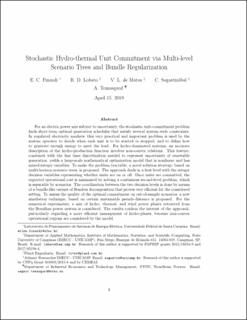Stochastic hydro-thermal unit commitment via multi-level scenario trees and bundle regularization
Peer reviewed, Journal article
Accepted version

Åpne
Permanent lenke
https://hdl.handle.net/11250/2650974Utgivelsesdato
2019Metadata
Vis full innførselSamlinger
Sammendrag
For an electric power mix subject to uncertainty, the stochastic unit-commitment problem finds short-term optimal generation schedules that satisfy several system-wide constraints. In regulated electricity markets, this very practical and important problem is used by the system operator to decide when each unit is to be started or stopped, and to define how to generate enough energy to meet the load. For hydro-dominated systems, an accurate description of the hydro-production function involves non-convex relations. This feature, combined with the fine time discretization needed to represent uncertainty of renewable generation, yields a large-scale mathematical optimization model that is nonlinear and has mixed-integer variables. To make the problem tractable, a novel solution strategy, based on multi-horizon scenario trees, is proposed. The approach deals in a first level with the integer decision variables representing whether units are on or off. Once units are committed, the expected operational cost is minimized by solving a continuous second-level problem, which is separable by scenarios. The coordination between the two decision levels is done by means of a bundle-like variant of Benders decomposition that proves very efficient for the considered setting. To assess the quality of the optimal commitment on out-of-sample scenarios, a new simulation technique, based on certain sustainable pseudo-distance is proposed. For the numerical experiments, a mix of hydro, thermal, and wind power plants extracted from the Brazilian power system is considered. The results confirm the interest of the approach, particularly regarding a more efficient management of hydro-plants, because non-convex operational regions are considered by the model.